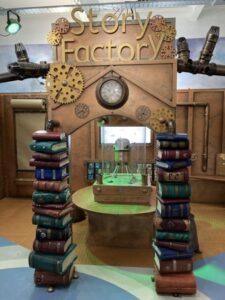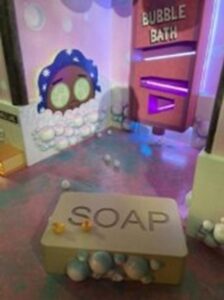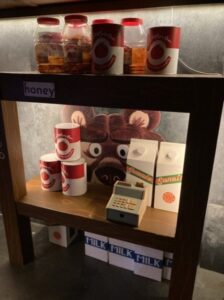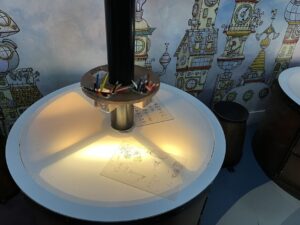The Discover Children’s Story Centre is place for children, between the ages of 0-11, to improve their reading, writing, speaking and listening skills in an inspiring, fun and imaginative way. Children are encouraged to create their own stories for the centre’s baby space alien Hootah, whose home planet, Squiggly Diggly, has run out of new stories.
The centre has three main areas to explore:
- Story World. The main interactive space set across two floors and an outside space.
- Temporary Interactive Exhibition. A space where the content changes annually (the Box Rocket exhibition was there when we visited).
- A workshop space. For additional storytelling’s and workshops.
Throughout the building, including the staircases, are features which have been designed to promote the skills used in story making and to inspire creativity. Everywhere you look there are lots of beautiful illustrations and objects created for the centre which really add to the welcoming atmosphere.
Even the café hasn’t escaped these creative touches, which features an exhibition on the staff’s favourite children’s books which have been chosen from each year that the centre has been open.
Being immersed in such a creative environment we are certain it brings a sense of wonder to all the visiting families and schools.

During our visit we were on the lookout for examples of good practice that relate to our engagement reflections points. Here’s what we found…
BuildING Confidence and ownership
Stepping into Story World was like walking into a different world entirely. It was full of imagination boosting castles, boats, mountains and a tree with tiny rooms hidden throughout – it was a wonderfully welcoming space.
Visitors are given the opportunity to write, draw, act with costumes or create a character of a story all of their own. There is no pressure to do so, nor is there a “right way” of interacting with the space.
This gives visitors a sense of agency and the permission to play, and enjoy what is there in the way that suits them. We certainly wanted to get involved and explore what else was hidden within the walls and trees in the space (there were plenty of surprises to be found).
Providing additional support for visitors, are ‘Story Builders’. These are the Centre’s staff members who are there to help, interact, and play with visitors – as well as delivering the workshops and running storytelling sessions for schools and families.
The Story Builders seem to provide a really positive example for creating stories. Many of the stories that they tell have been written by themselves. This supports children to feel more confident in sharing and delivering their own stories or going to them for help and inspiration.
UsING EVeryDAY EXAMPLES
Throughout the Discover Centre, are spaces which let children blend their imagination with the aspects of the ‘everyday – they can go shopping in a mini-supermarket or they can engage playfully with the natural world. The only limit is their own imagination.
An example of this involves clouds, or more precisely seats that look like clouds., Clouds are something many children will have seen, but never touched. Here they have created seats which look like clouds that the children can sit or crawl on and be playful which is a lovely blend of the normal and the imaginative.
Another great space to find everyday examples is in the The Box Rocket exhibition. This is a ‘story world’ that is interactive and immersive and is designed for everyone age 0-8, and their families, to become a part of a imaginary world of play and storytelling.
The space themed exhibition was made up of different sections with the characters and illustrations by Dapo Adeola who also illustrated the children’s book “Look Up” and with the story for the exhibition made by Tola Okogwu.

One part that really stood out to us was the bubble bath section. The idea of bubbles, soap and baths is something that most children will have experienced. They had created an enormous bubble bath with rubber ducks and bubbles which the children make race down some tubes into the bath.
Alongside the bubble bath section, a favourite part was the grocery shop area – a lovely space for children to experience being both a customer and a shopkeeper. It came fully equipped with a till, card machine and fully stocked shelves (although we were glad we didn’t have tidy up at the end of the day!).
with a till, card machine and fully stocked shelves (although we were glad we didn’t have tidy up at the end of the day!).
The ‘everyday’ is an impactful setting. It it easy to assume that all children have the same day-to-day experiences. Maybe some children have been to the post office or a local greengrocer and for others they might be entirely new concept.
Highlights and develops skills
Developing children’s literacy and reading skills is a key aim for the Centre, and so is showing children how important creativity and play is.
With a broad focus age range of 0–11-year-olds, each of these age ranges have different needs and will be at different developmental stages. Across the Centre’s spaces, they have ensured that each age group has an opportunity to explore and develop their skills through play, creativity and imagination.
Specific skills such as fine motor skills, handwriting and creative thinking and writing are introduced and developed through craft tables, dressing up, reading and writing spaces.
OUR REFLECTIONS
The Discover Centre is a wonderful place for visitors to see how inspiring and fun story-making can be. By having this passion present throughout the whole building, in their workshops and exhibitions it enable visitor to be completely immersed in these ideas.
It was great to see how they have made everyday things full of wonder, joy and excitement for young children – and even ourselves as adults.
Our Early Years blog series shares insights from the research, development, and delivery of our work across the Science Museum Group with early years audiences.
What to read next:
If you have enjoyed this blog, then here are some with a similar theme we recommend you read next.